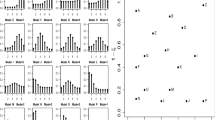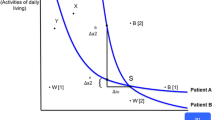Abstract
A marginal maximum likelihood (MML) estimation method is developed for the analysis of both categorical rating data and choice data for decision making in the context of uncertain outcomes. The proposed method fits the weighted additive models with interaction terms to the data, allowing for individual differences in weights, category boundaries, and thresholds. The present study demonstrates that the MML approach will be useful for dealing with individual differences in those variables as well as the subject points previously dealt with within the framework of multidimensional scaling. Bock and Aitkin’s EM algorithm is used for the MML estimation of the proposed models.
Similar content being viewed by others
References
Akaike, H. (1974). A new look at the statistical model identification. IEEE Transaction on Automatic Control, 19, 716–723.
Baker, F.B. (1992). Item response theory: Parameter estimation techniques. New York: Marcel Decker, INC.
Bock, R.D. & Aitkin, M. (1981). Marginal maximum likelihood estimation of item parameters: Application of an EM algorithm. Psychometrika, 46, 443–459.
Bock, R.D. & Jones, L.V. (1968). The measurement and prediction of judgment and choice. San Francisco: Holden-Day.
Bock, R.D. & Lieberman, M. (1970). Fitting a response model for n dichotomously scored items. Psychometrika, 35, 179–197.
Carroll, J. D. & Chang, J. J. (1970). Analysis of individual differences in multidimensional scaling via an N-way generalization of “Eckart-Young” decomposition. Psychometrika, 35, 283–319.
Dempster, A.P., Laird, N.M., & Rubin, D.B. (1977). Maximum likelihood from incomplete data via the EM algorithm (with discussion). Journal of the Royal Statistical Society, Series, B, 39, 1–38.
DeSarbo, W.S. & Cho, J. (1989). A stochastic multidimensional scaling vector threshold model for the spatial representation of “pick any/n” data. Psychometrika, 54, 105–129.
Hojo, H. (1988). Analysis of saliency of facial features through psychophysical scaling. Japanese Psychological Research, 30, 42–46.
Hojo, H. (1997). A marginalization model for the multidimensional unfolding analysis of ranking data. Japanese Psychological Research, 39, 33–42.
Hojo, H. (1998). Multidimensional unfolding analyses of ranking data for groups. Japanese Psychological Research, 40, 166–171.
Ibaraki, T. & Fukushima, M. (1991). FORTRAN programming for optimization. (In Japaneses.) Tokyo: Iwanami Shoten.
Shiono, K., Masumoto, S., & Wadatsumi, K. (1988). BASIC prograrns for contour maps II. (In Japansese.) Tokyo: Kyouritu Shuppan.
Takane, Y. (1981). Multidimensional successive categories scaling: A maximum likelihood method. Psychometrika, 46, 9–28.
Takane, Y. (1982). Maximum likelihood additivity analysis. Psychometrika, 47, 225–241.
Takane, Y. (1983). Choice model analysis of the “pick any/n” type of binary data. Handout for the talk given at the European Psychometric and Classification Meeting, Jouy-en-Josas.
Takane, Y. (1996). An item response model for multidimensional analysis of multiple-choice data. Behaviormetrika, 23, 153–167.
Takane, Y. (1998). Choice model analysis of the “pick any/n” type of binary data. Japanese Psychological Research, 40, 31–39.
Takane, Y., Bozdogan, H., & Shibayama, T. (1987). Ideal point discriminant analysis. Psychometrika, 52, 371–392.
Takane, Y. & de Leeuw, J. (1987). On the relationship between item response theory and factor analysis of discretized variables. Psychometrika, 52, 393–408.
Torgerson, W.S. (1958). Theory and methods of scaling. New York: Wiley.
Author information
Authors and Affiliations
About this article
Cite this article
Hojo, H. Marginal Maximum Likelihood Analyses of Individual Differences in Additivity and Judgmental Criteria for Categorical Rating Data and Decision Making Data. Behaviormetrika 27, 153–180 (2000). https://doi.org/10.2333/bhmk.27.153
Received:
Revised:
Published:
Issue Date:
DOI: https://doi.org/10.2333/bhmk.27.153




